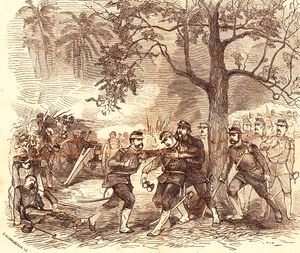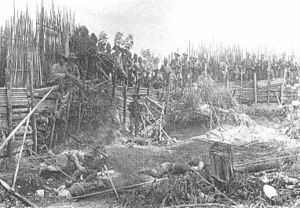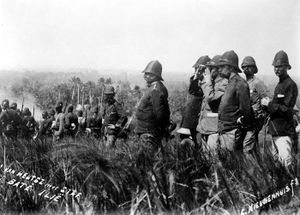حرب آتشيه
| حرب آتشيه Aceh War | |||||||||
|---|---|---|---|---|---|---|---|---|---|
 الجنرال ج.هـ.ر. كولر قتيلاً في مسيگيت. | |||||||||
| |||||||||
| المتحاربون | |||||||||
|
| |||||||||
| القادة والزعماء | |||||||||
|
|
| ||||||||
| القوى | |||||||||
|
3,000 فرد (التجريدة الأولى على آتشيه)[3] 13,000 (التجريدة الثانية على آتشيه)[3] 12,000 European KNIL troops (1903)[2] 23,000 Indonesian KNIL troops[2] | 10,000-100,000 فرد [7] | ||||||||
| الضحايا والخسائر | |||||||||
| 37,000 قتيل [2] |
60-70,000 قتيل[2] 10,000 refugees[2] | ||||||||
| هذا المقال هو جزء من سلسلة تاريخ إندونيسيا |
|---|

|
| انظر أيضاً: |
| قبل التاريخ |
| الممالك المبكرة |
| سري ڤيجايا (القرون الثالث إلى الرابع عشر) |
| تاروما نگارا (358-723) |
| سايلندرا (القرنان الثامن والتاسع) |
| مملكة سوندا (669-1579) |
| مملكة مطرم (752–1045) |
| كديري (1045–1221) |
| سنغاساري (1222–1292) |
| ماجاپاهيت (1293–1500) |
| نشأة الدول الإسلامية |
| انتشار الإسلام (1200–1600) |
| سلطنة ملقا (1400–1511) |
| سلطنة دماك (1475–1518) |
| سلطنة آچه (1496–1903) |
| سلطنة بانتن (1526–1813) |
| سلطنة مطرم (1500s to 1700s) |
| الاستعمار الاوروبي |
| البرتغاليون (1512–1850) |
| شركة الهند الشرقية الهولندية (1602–1800) |
| الهند الشرقية الهولندية (1800–1942) |
| بزوغ إندونيسيا |
| الصحوة الوطنية (1899–1942) |
| الاحتلال الياباني (1942–45) |
| إعلان الإستقلال (1945) |
| الثورة الوطنية (1945–1950) |
| إندونيسيا المستقلة |
| الديمقراطية الليبرالية (1950–1957) |
| الديمقراطية المهدية (1957–1965) |
| بداية النظام الجديد (1965–1966) |
| النظام الجديد (1966–1998) |
| عصر الإصلاح (1998–الحاضر) |
| عدّل هذا القالب |
حرب آتشيه Aceh War، أو الحرب الهولندية أو حرب الإلحاد (1873—1913),[1]، كان نزاع مسلح بين سلطنة آتشه وهولندا، نشب عن المناقشات بين ممثلي آشه والولايات المتحدة في سنغافورة في أوائل 1873.[8] كان النزاع جزءاً من سلسلة صراعات في أواخر القرن التاسع عشر رافقت الحكم الهولندي على إندونسيا المعاصرة، بالتزامن مع التدخلات في بالي عام 1908.[9]
خلفية
For much of the 19th century, Aceh's independence had been guaranteed by the Anglo-Dutch Treaty of 1819 and its status as a protectorate of the Ottoman Empire since the 16th century. During the 1820s, Aceh's became a regional political and commercial power, supplying half of the world's pepper which increased the revenues and influence of local feudal rajas.[10] Growing European and American demand for pepper led to a series of diplomatic skirmishes between the British, French and Americans. During the reign of Sultan Tuanku Ibrahim (1838–1870), the Aceh Sultanate brought the regional rajas under control and extended its domain over the east coast.[10] However, this southward trend clashed with the northwards expansion of Dutch colonialism in Sumatra.[10]
Following the 1869 opening of the Suez Canal and changing shipping routes, the British and Dutch signed the 1871 Anglo-Dutch Treaty of Sumatra which ended British territorial claims to Sumatra, allowing the Dutch a free hand within their sphere of influence in Maritime Southeast Asia while handing them the responsibility to check piracy.[3] In return, Britain gained control of the Dutch Gold Coast in Africa and equal commercial rights in Siak.[7] Dutch territorial ambitions in Aceh were fuelled by a desire to exploit its natural resources, especially black pepper and oil, and to eliminate an independent native state player. The Dutch also sought to ward off other rival colonial powers that had ambitions in Southeast Asia, particularly the British and the French.[11]
العمليات القتالية
الهجوم الهولندي الأول
الهجوم الهولندي الثاني
الحرب المقدسة
التهدئة
ما بعد الحرب

هوامش
- المصادر
- المراجع
- ^ أ ب ت ث ج ح خ د ذ Ibrahim (2001), p. 133 خطأ استشهاد: وسم
<ref>غير صالح؛ الاسم "Ibrahim133" معرف أكثر من مرة بمحتويات مختلفة. - ^ أ ب ت ث ج ح Vickers (2005), p. 13
- ^ أ ب ت ث ج Ibrahim (2001), p. 132
- ^ خطأ استشهاد: وسم
<ref>غير صحيح؛ لا نص تم توفيره للمراجع المسماةRicklefs145 - ^ Anthony Reid (2005), p. 336
- ^ Anthony Reid (2005), p. 352
- ^ أ ب Ricklefs (2001), p. 144
- ^ Ricklefs (2001), p. 185-88
- ^ Vickers (2005), pp. 14
- ^ أ ب ت Ricklefs (1993), p. 143
- ^ Vickers (2005), p. 10
المصادر
- Ibrahim, Alfian. "Aceh and the Perang Sabil." Indonesian Heritage: Early Modern History. Vol. 3, ed. Anthony Reid, Sian Jay and T. Durairajoo. Singapore: Editions Didier Millet, 2001. 132-133
- Reid, Anthony (2005). An Indonesian Frontier: Acehnese & Other Histories of Sumatra. Singapore: Singapore University Press. ISBN 9971-69-298-8.
{{cite book}}: Cite has empty unknown parameter:|coauthors=(help) - Ricklefs, M.C (1993). A History of Modern Indonesia Since c. 1300. Hampshire, UK: MacMillan Press. pp. 143–46. ISBN 978-0804721950.
{{cite book}}: Cite has empty unknown parameter:|coauthors=(help) - Vickers, Adrian (2005). A History of Modern Indonesia. New York: Cambridge University Press. pp. 10–13. ISBN 0-521-54262-2.
{{cite book}}: Check|isbn=value: checksum (help); Cite has empty unknown parameter:|coauthors=(help)

